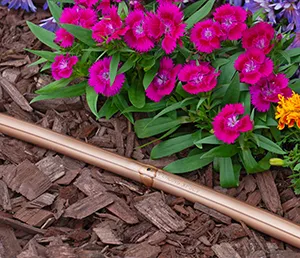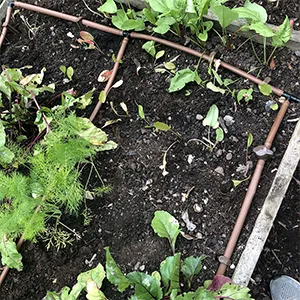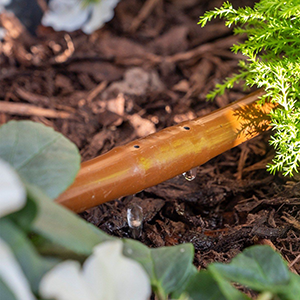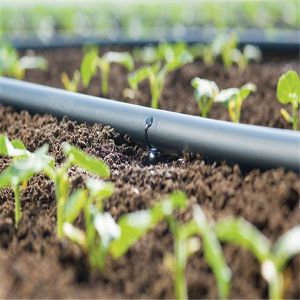
Which Drip Line Should I Use?
Once you know the area that you wish to water, it's essential to know the options and features of the different types of Drip Line. HydroSure offer a fantastic range of Drip Line with unique features and varying litre per hour/dripper spacing that provide precise solutions that work for any garden or irrigation project.
This guide will help determine the ideal Drip Line to select, but if you want more information about setting up and maintaining your Drip Line, check out our Drip Line Buyers Guide, or if you need to know how much Drip Line you require in your system, take a look at our guide on How to Calculate Drip Line Length and Run Time.
Frequently Asked Questions

I have a small area to water, including plant pots and ornamental trees
- Micro drip line/dripper hose is a 4mm pipe made from flexible PVC for an easy irrigation system designed to water pots, planters, flower beds, shrubs and trees.

I have a vegetable patch and would like to set up an irrigation system.
OR
I have a sloped and variable landscaped terrain to water.
- The ideal choice would be HydroSure 13/14mm Pressure Compensating Drip Line.
- 13/14mm Drip Line is ideal for vegetable patches, garden beds, hedges, and nature strips. Pressure compensated emitters ensure consistent amounts of water is delivered along the entire length of pipe, even on differing terrain levels.
- We suggest setting up the system in a grid formation. You might also consider inserting valves for you to close off watering lines to provide more flexibility and seasonal planting.

I have reliable water pressure and a relatively flat surface to water.
- For this scenario, any Drip Line is suitable.
- The best value for money Drip Line would be our HydroSure 13/14mm Drip Line.

I would like to bury Drip Line, can Drip Line be buried?
- We recommend choosing HydroSure 13/14mm Anti-Siphon Drip Line.
- The in-built drippers feature PC and anti-siphon mechanisms, which compensate and balance differential pressure. The vacuum within the pipe prevents the aspiration of soil and sand particles through the dripper outlet.

What Drip Line is best for a longer length of hedge planting?
- The best choice would be to use a HydroSure 18mm Drip Line.
-
HydroSure 18mm Drip Line is the perfect choice when running longer lengths of pipe. You can run the pressure-compensated version up to 283m when using 2 bar Pressure. Ideal for larger garden beds, hedges, and nature strips. The larger diameter causes less friction loss, which reduces pressure loss making the 18mm pipe more efficient at watering longer distances.

My soil is sandy and I find it difficult to water using a watering can and hose pipe.
- We would advise Closely Spaced HydroSure Drip Line (15cm).
-
Sandy soil moves water quickly in a vertical wetting pattern. Using closer spaced Drip Line with a higher flow rate and watering less and more frequently is recommended.

My soil is a clay soil and often pools water on the surface when watering.
- Low L/h HydroSure Drip Line (0.85L/h) will help prevent this.
-
Clay soil absorbs water more slowly. Use a slower flow rate to avoid water pooling on the surface and water for long periods with a low flow rate to ensure plants receive enough water.

My Drip Line isn’t Working
Common Drip Line Problems
• Drippers not emitting along the length: Check the water flow rate from the tap outputs enough water for each emitter’s requirements. Our Drip Line Calculation Guide features a working example to help you check this information.
• Dry spots and some drippers not working: Over time emitters can become clogged with insects or dirt. Flush the system by removing the end caps and switching on the water flow to flush out any debris.
• Structural Damage: Digging in the garden can pierce the pipe wall and will affect emitter performance. Walk along the length of your Drip Line whilst the system is switched on to see if there is any visible damage or for Drip Line that has been buried, check for areas where water is pooling which might indicate split pipe. Damaged irrigation pipe is easily replaced by cutting out the damaged pipe using Pipe Cutters and connecting the Drip Line back together using a Barbed/Nut Lock Joiner.
• Pressure Loss: Make sure any open end of the Drip Line is plugged using an End Cap. This maintains water pressure at the correct level for emitters to function.

Can Drip Line be extended or cut to length?
Drip Line can easily be extended using a Joiner the same size as the internal diameter of your pipe. Top Tip: Be sure to check your water pressure and flow rate to ensure there is enough available water from your tap to accommodate the extra length of Drip Line and check our Drip Line Run Length Guide.
Alternatively, shorten your Drip Line to the required length using Pipe Cutters making sure to avoid cutting the pipe at any emitter sites.

How can I connect my Drip Line to a Garden Hose Pipe?
For easy connection between your hose pipe and Drip Line, use an Accessory Adaptor to join the Hose End Connector from your garden hose to a Barbed Tap Connector or Nut Lock Tap Connector compatible with your Drip Line.
You can also use LDPE Irrigation Pipe to take water to your Drip Line system, simply join each length using a Barbed or Nut Lock Joiner that fits the diameter of your pipe. Top Tip: Use a Reducing Joiner if you are using supply pipe and Drip Line of different sizes.

Can Drip Line be run from a Water Butt?
A small Drip Line irrigation system can easily be fed from a Water Butt. We recommend using 4mm Drip Line or a short length of up to 15 metres of 14mm non-pressure compensated Drip Line. Top Tip: Irrigation systems fed directly from a water butt rely completely on the pressure generated from gravity. To increase the pressure, raise the height of your water butt by installing it on a Water Butt Stand. Most water butts feature a tap complete with a barbed outlet that 14mm dripline can be installed to directly. For more information, visit our Water Butt Irrigation System Guide.

Can Drip Line be left out during the winter?
HydroSure Drip Line is manufactured from high-quality weather-resistant materials and can remain in place without uplifting at the end of the watering season. To further prolong the life of the pipe structure and emitter outlets, flush the system throughout the watering season and at the time of final watering before the winter months. To flush a drip line, remove the End Caps and switch the system on for 2-3 minutes to allow any internal debris to wash out. Switch the system off and allow the pipe to drain before replacing the end caps to ensure there is no sitting water. Once the system has finished draining, replace the end caps to prevent insects from crawling in and blocking emitter outlets.
Top Tip: A Flushing Valve or Adjustable Valve can be installed instead of an End Cap for dual functioning flushing and draining capabilities without cutting the pipe and purchasing new end caps each time.

Drip Irrigation vs. Soaker Hose
Both Soaker Hose and Dripline are one of the most effective watering methods as they deliver water directly to the plant's roots. Drip Line, however, delivers a uniform application of water and with much longer run lengths up to 200 metres that are both consistent and easily measurable by litre per hour output. Dripline is also available with built-in Pressure Compensation ideal for sloped terrain and Anti-Siphon varieties for reliable protection against root intrusion when installed sub-surface.
A soaker hose is a more flexible irrigation method as water seeps through the porous layers along the length rather than at individually spaced outlets where the drip line is concerned. Whilst the soaker hose is easier to set up as it is compatible with connectors that fit a regular garden hose pipe, it is limited to run lengths of up to 30 metres when using a 13mm Soaker Hose and up to 80 metres when using a 16mm Soaker Hose.
The accurate and reliable delivery of water from drip line requires initial expense and maintenance in terms of additional Filters and system flushing to minimise emitter blockages. Soaker hose, however, tends not to block so requires minimal planning when building a soaker hose system.
The water flow and pressure affect the water distribution in any irrigation project, friction will reduce the flow rate of water along a length of pipe. The diameter, terrain, and length of pipe will all impact the consistency of water output.
Refer to our table below for suggested maximum run lengths of Drip Line.
*The table below is a suggestion only, based on an average 1.8 l/h emitter output.

What is Value Drip Line?
Value Drip Line is ideal for watering on a flat surface and gives a flow rate which is dependent on the supplied working pressure. Each dripper flow rate is affected by the pipe diameter, dripper spacing and length of pipe. Differences in the topography variances will also affect the dripper output.
What is Pressure Compensating Drip Line?
Pressure compensating Drip Line (often referred to as PC Drip Line) means you can run a length of Drip Line and ensure accurate and consistent water is delivered along the entire length of pipe. The engineered drippers emit the same flow of water across varying terrain, including slopes. The inbuilt labyrinth provides precise watering and self-flushing technology which maintains differential pressure within the pipe ensuring a uniform flow of water.
What is Anti Siphon Drip Line?
Anti Siphon Drip Line has in-built drippers featuring PC and anti-siphon mechanisms which prevent the aspiration of sand and soil particles through the dripper outlet, making this Drip Line particularly well-suited for use underground - usually 50mm-100mm below the surface.

Different Litres per hour (L/h)
There are multiple different litres per hour to choose between when deciding your HydroSure Drip Line. 0.85L/h 1.6L/h, 1.8L/h, 2L/h, 2.1L/h and 2.3 L/Hour output are all different outputs that our Drip Line offers. The outputs help you choose the ideal watering duration and output for your irrigation project. Planting, climate, and soil type will all impact your choice.

Different Dripper Spacing
The spacing options allow you to select the ideal pipe based on soil type and irrigation project. 15cm spacing provides a more flexible option to allow you to water more for a shorter run time. The closer spacing allows you to irrigate smaller areas in an efficient, cost-effective solution. 30cm to 50cm spacing is great for larger areas like borders and hedging.
Further Drip Line Information
For further information on how to install a drip line garden watering system, including how to calculate drip line lengths and how to install and maintain a system, read our How to guides.








